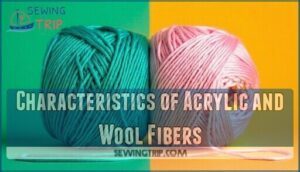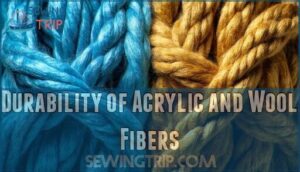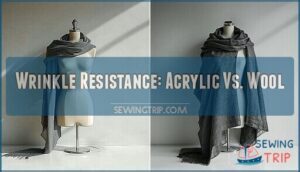This site is supported by our readers. We may earn a commission, at no cost to you, if you purchase through links.

Acrylic bounces back from stretching like it never happened, but wool’s got that breathable, soft feel you can’t fake. If you’re watching your wallet or need something kid-proof, acrylic’s your friend. For cozy sweaters and baby blankets, wool takes the crown.
The real trick lies in knowing which projects demand what qualities.
Table Of Contents
- Key Takeaways
- Acrylic Felt
- Wool Felt
- Woven Wool Felt
- Where Do Acrylic and Wool Fibers Come From?
- Characteristics of Acrylic and Wool Fibers
- Durability of Acrylic and Wool Fibers
- Wrinkle Resistance: Acrylic Vs. Wool
- Comfort: Acrylic Vs. Wool
- Allergy Considerations: Acrylic Vs. Wool
- Cost Difference: Acrylic Vs. Wool
- Care and Maintenance: Acrylic Vs. Wool
- Different Types of Projects: Acrylic Vs. Wool
- Frequently Asked Questions (FAQs)
- Conclusion
Key Takeaways
- You’ll save 200% on costs with acrylic, but you’re trading wool’s superior warmth and breathability for synthetic convenience and easy machine washing.
- Acrylic bounces back from stretching like nothing happened, while wool absorbs moisture naturally and regulates temperature better against your skin.
- If you’ve got sensitive skin or need kid-proof materials, acrylic won’t trigger allergic reactions like wool’s lanolin might, plus it’s completely machine washable.
- Choose acrylic for everyday items needing frequent washing and bright colors that won’t fade, but pick wool for cozy winter gear and projects where natural breathability matters most.
Acrylic Felt
Why choose acrylic felt for your fiber arts projects? You’ll find this synthetic material budget-friendly and colorfast, making it perfect for beginner craft materials. Acrylic fibers resist fading and come in vibrant colors that won’t bleed during washing.
However, acrylic felt lacks the durability of natural alternatives, so it’s best for decorative projects rather than items requiring heavy use. These fabric properties make acrylic blends ideal for holiday decorations, card making, and experimental felt crafting where textile science isn’t critical.
Wool Felt
Wool felt brings natural elegance to your textile art projects. Made from genuine wool fiber, this material offers outstanding performance that synthetic alternatives can’t match.
You’ll appreciate these key advantages:
- Outstanding Durability: Natural wool felt withstands heavy use better than acrylic felt, making it perfect for heirloom projects that need to last generations.
- Impressive Workability: Wool fiber responds beautifully to felt making techniques, creating smooth edges and precise cuts for detailed wool crafting.
The natural properties of felted wool give you breathability and moisture resistance that synthetic materials lack. You’ll find wool felt holds its shape better during cutting and sewing, which saves time on complex textile art projects.
Care requires gentle handling – spot clean with mild detergent rather than soaking. This preserves the natural fibers and prevents shrinkage. While woven wool felt costs more upfront, you’re investing in quality that pays off through better results and longevity.
Woven Wool Felt
Understanding woven wool felt starts with recognizing its dense, thick texture that sets it apart from regular felt materials. This premium material combines wool fiber blends through specialized wool yarn weaving techniques, creating felted wool textures perfect for demanding projects.
| Property | Woven Wool Felt | Regular Felt |
|---|---|---|
| Thickness | Extra thick | Standard |
| Durability | Exceptional | Good |
| Natural dyeing | Excellent | Variable |
| Felt crafting uses | Heavy-duty projects | General crafts |
You’ll find this natural fiber excels in applications requiring strength and longevity, unlike synthetic fibers that may compromise over time.
Where Do Acrylic and Wool Fibers Come From?
Acrylic and wool couldn’t be more different in how they’re made. Acrylic starts with acrylonitrile, a petroleum-based chemical that gets spun into fibers through industrial processes.
Wool? It’s just sheep doing what they do naturally, growing protective fleece that we harvest and turn into yarn.
Wool is just sheep naturally growing protective fleece that we harvest and turn into yarn
- Fiber Sources: Acrylic production reached 1.57 million tons in 2025, while wool requires livestock farming
- Synthetic Production: Chemical spinning transforms petroleum into acrylic through industrial processes
- Natural Resources: Sheep naturally grow wool fibers as protective protein coats
- Textile History: Acrylic emerged in the 1940s, but wool’s been around for millennia
- Textile Industry: Both serve different market needs—acrylic for affordability, wool for premium applications
The growth of the acrylic fibre market is driving innovation in textile production.
Understanding these origins helps you pick the right fiber for your project’s specific needs.
Characteristics of Acrylic and Wool Fibers
These materials show some pretty clear differences that matter for how they perform. Acrylic keeps its colors bright and won’t fade on you, while wool is a moisture magnet—it can soak up half its weight in water vapor.
Wool feels softer and breathes better than synthetic options, but acrylic and other synthetics won’t catch fire as easily.
- Acrylic maintains vibrant colors through repeated washing cycles
- Wool absorbs moisture naturally, keeping you comfortable
- Synthetic fibers recover 99% from stretching at 2% elongation
- Natural wool fibers feel softer but may irritate sensitive skin
- Fiber strength varies: acrylic spans 18-36 g/tex when dry
The choice between acrylic and wool often depends on understanding yarn fiber types and their specific characteristics.
Durability of Acrylic and Wool Fibers
When it comes down to durability, acrylic synthetic fibers pack more punch than you’d expect. Acrylic yarn beats wool in yarn endurance tests, with breaking strengths ranging from 22,000 to 39,000 psi compared to wool’s 260 MPa.
This material strength means better wear resistance and fabric tear protection. While wool natural fibers shine in moisture absorption, acrylic maintains consistent fiber longevity even after repeated washing and sun exposure, making it the practical choice for everyday durability.
Wrinkle Resistance: Acrylic Vs. Wool
When it comes to wrinkles, acrylic wins hands down over wool. The synthetic fibers bounce back from creasing like magic—toss an acrylic sweater in your bag and it’ll look fresh when you pull it out.
Wool needs more babying but gives you things acrylic can’t: it stretches better and lets your skin breathe.
| Feature | Acrylic | Wool |
|---|---|---|
| Wrinkle Recovery | Excellent – bounces back quickly | Good – needs gentle handling |
| Ironing Tips | Low heat or steam | Medium heat with pressing cloth |
| Fabric Blending | Works well with synthetics | Best with natural fibers |
Comfort: Acrylic Vs. Wool
Feel-good factors matter when you’re choosing between these materials. Acrylic traps heat and moisture against your skin, creating that clammy feeling nobody wants. Wool’s natural fibers let your skin breathe.
| Comfort Factor | Acrylic | Wool |
|---|---|---|
| Breathability | Poor | Excellent |
| Moisture Management | Traps sweat | Wicks moisture |
| Temperature Regulation | Overheats | Adapts naturally |
Wool excels at moisture management and temperature regulation. Its natural fibers pull sweat away from your body, while acrylic holds it close. That’s why wool feels comfortable during temperature changes, while acrylic leaves you feeling sticky.
Here’s the trade-off: wool can irritate sensitive skin with its natural texture. Some people find it scratchy or experience fabric irritation. Acrylic’s synthetic softness won’t trigger these reactions.
Your lifestyle determines the winner. Active people benefit from wool’s breathability factors and natural temperature control. Those with sensitive skin might prefer acrylic’s gentle touch despite its poor moisture-wicking abilities.
Allergy Considerations: Acrylic Vs. Wool
If you’ve got sensitive skin or wool allergies, you’ll want to pay close attention to material choice.
Acrylic offers a hypoallergenic alternative that won’t trigger reactions, while wool can cause itching and irritation for some people.
Allergic Reactions to Wool
True wool allergies are much rarer than you’d think. Most reactions stem from lanolin, a wax derived from sheep’s wool, not the wool fibers themselves. Modern research shows wool fiber isn’t a cutaneous allergen. Your skin irritation likely comes from processing chemicals rather than natural fibers.
| Reaction Type | Cause |
|---|---|
| True Wool Allergies | Extremely rare |
| Lanolin Sensitivity | Sheep wool wax |
| Chemical Reactions | Processing additives |
| Fiber Sensitivity | Coarse texture irritation |
| Allergic Responses | Usually lanolin-based |
Benefits of Acrylic
When you’re looking for freedom from allergy worries, acrylic yarn becomes your best friend. This synthetic superstar offers easy care with machine washable convenience, plus excellent color retention that won’t fade. You’ll love its soft texture and quick drying properties, making it perfect for busy lifestyles seeking affordable options.
| Feature | Acrylic Advantage | Why It Matters |
|---|---|---|
| Allergies | Hypoallergenic | No wool proteins |
| Care | Machine washable | Saves time/money |
| Colors | Fade-resistant | Looks new longer |
Durability of Both Materials
When you’re investing in fabric, you want something that’ll last. Acrylic and wool both deliver on durability, just in different ways.
Acrylic’s synthetic makeup gives you reliable wear resistance that stays consistent over time.
Wool takes a different approach—its natural fibers have built-in elasticity and can actually repair minor damage on their own.
| Durability Factor | Acrylic | Wool |
|---|---|---|
| Material Strength | High synthetic resilience | Natural elasticity advantage |
| Fabric Longevity | 5-10 years typical wear | 10-20+ years with care |
| Wear Resistance | Excellent against pilling | Outstanding against stretching |
| Maintenance Impact | Machine-friendly durability | Requires gentle handling |
| Yarn Properties | Colorfast, shape-stable | Self-repairing, breathable |
Cost Difference: Acrylic Vs. Wool
Looking at material costs, acrylic delivers significant savings compared to wool. In 2025, acrylic averages $2-3 per kilogram, while wool exceeds $8 per kilogram—creating a 200% price gap. This cost difference impacts your yarn budget and fabric expenses across all projects.
| Material Type | Acrylic Cost | Wool Cost |
|---|---|---|
| Yarn (per skein) | $3-10 | $8+ |
| Fiber (per kg) | $2-3 | $8+ |
| Production Fees | Lower | Higher |
Acrylic’s synthetic nature facilitates mass production efficiency, while wool’s natural yarn properties require more complex processing. Despite sustainability concerns, acrylic remains the budget-friendly choice for cost-conscious crafters.
Care and Maintenance: Acrylic Vs. Wool
Taking care of your fabric properly makes all the difference in how long it lasts. When it comes to washing and caring for these materials, acrylic and wool are basically opposites.
Machine washability sets acrylic apart as the clear winner for busy lifestyles. You can toss acrylic into your washer at temperatures up to 40°C without worry, while wool demands gentle cycles below 30°C to prevent shrinkage. That’s cost-effective convenience you can count on.
Washing Temperature
Drying Method
Stain removal becomes straightforward with acrylic’s 22% higher resistance to water-based stains. For fabric softening and durability, acrylic maintains 98% of its original dimensions post-wash, while wool can lose up to 16% of its size. Your washing frequency drops dramatically too—acrylic needs cleaning every 8-10 wears versus wool’s 2-3 wears.
Different Types of Projects: Acrylic Vs. Wool
Choosing the right yarn comes down to matching what you’re making with what the fiber does best. When you pick yarn that fits your project’s needs, everything just works better.
Wool yarn shines in these scenarios:
- Winter sweaters and scarves (outstanding warmth retention)
- Baby blankets (natural breathability prevents overheating)
- Socks and mittens (durability withstands heavy wear)
Acrylic yarn dominates when you need:
- Machine-washable items like dishcloths
- Bright, colorfast children’s clothing
- Budget-friendly practice projects for new knitting tips
Project Type Best Choice
Blended yarns give you the best of both worlds—wool’s cozy warmth with acrylic’s easy care.
Think about what matters most: Are you making something that needs regular washing? Do you want natural fibers over synthetic ones?
For crochet patterns requiring structure, wool’s elasticity helps stitches maintain shape. Acrylic works better for crochet projects needing frequent washing. Your knitting projects succeed when yarn properties align with intended use—it’s that simple.
Frequently Asked Questions (FAQs)
What is the difference between wool and acrylic yarn?
Think of wool as nature’s cozy blanket—it’s breathable, durable, and flame-resistant but needs gentle care.
You’ll find acrylic acts like a synthetic superhero—easy to wash, colorfast, and budget-friendly, though less breathable than wool.
What is the difference between wool and acrylic insulation?
Wool insulation naturally regulates temperature and resists moisture, while acrylic insulation offers synthetic durability and consistent performance.
You’ll find wool breathes better, but acrylic maintains its shape longer and costs less.
Is wool softer than acrylic?
Generally, yes. Wool’s natural crimp and lanolin coating create softer fibers that feel more comfortable against your skin. Acrylic can feel scratchy or synthetic, especially lower-quality versions.
Why is acrylic yarn more wrinkle resistant than wool?
Synthetic fibers like acrylic hold their shape better than natural wool fibers. You’ll find acrylic’s chemical structure creates stronger bonds that resist creasing, while wool’s natural proteins bend and fold more easily under pressure.
Should you choose acrylic or wool?
Choose based on your needs: acrylic for easy care and budget-friendliness, wool for exceptional warmth and breathability. Your lifestyle determines the winner.
What are the disadvantages of acrylic vs wool?
Like choosing between a sports car and pickup truck, you’ll face trade-offs. Acrylic pills easily, lacks breathability, and isn’t recyclable. Wool shrinks, needs special care, and costs more upfront.
What is the difference between acrylic and wool felt?
Acrylic felt is synthetic and lightweight, while wool felt is natural and dense.
You’ll find acrylic felt easier to clean, but wool felt offers better durability and temperature regulation for your projects.
Is acrylic felt as durable as wool felt?
No, you’ll find wool felt outlasts acrylic felt considerably. Wool’s natural fibers bounce back from compression and resist wear better than synthetic acrylic, which is prone to pill and lose shape over time.
Can acrylic felt be washed?
Yes, you can wash acrylic felt easily. It’s machine washable and dryable, making it super low-maintenance compared to wool felt which needs gentle hand washing.
What are the best projects to use acrylic felt for?
You’ll love using acrylic felt for kids’ crafts, decorative items, and beginner projects. It’s perfect for ornaments, bookmarks, coasters, and simple toys since it’s affordable, colorfast, and machine-washable.
Conclusion
Like choosing between a trusty pickup truck and a sleek sports car, the acrylic vs wool difference ultimately depends on your specific needs.
Acrylic delivers unbeatable convenience and budget-friendly pricing for everyday projects. Wool offers exceptional warmth, breathability, and natural luxury for special occasions.
You can’t go wrong with either choice—just match the material to your project’s demands. Both have earned their place in your crafting arsenal.
- https://sewguide.com/wool-vs-acrylic-fabric-key-differences-which-is-better/
- https://www.statista.com/statistics/1260340/acrylic-fiber-production-worldwide/
- https://www.precedenceresearch.com/acrylic-fibers-market
- https://www.businessresearchinsights.com/market-reports/acrylic-yarn-market-100235
- https://sewport.com/fabrics-directory/acrylic-fabric
















